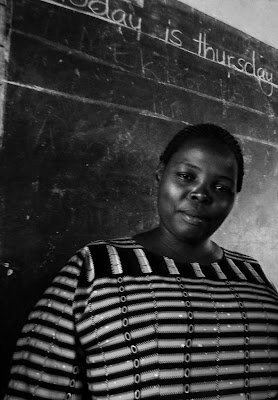A few weeks ago, in Jinja (a city about four hours away from my home), I bought a new wallet. I’d already
had a wallet that I’d bought in the Central Region of Uganda, and it is
beautifully made, but I’d bought it out of necessity and my only option at the
time was to buy one that is red and green—Christmas colors. I love Christmas colors... for exactly two
months of the year, and those months have come and gone. But this wallet had
held up very well for a wallet that cost only a few thousand shillings (maybe
two or three US dollars, I don’t remember exactly) so I kept using it.
Until I was
out shopping with my friends and I decided to treat myself and buy a new
wallet! I found one that was the same style, but had a beautiful print of
Africa in light brown and mint green. I bought it, and…promptly lost it. I put
the shopping bag that it was in underneath my chair when we went to the pool
that day, and I just forgot it. I felt like a total space case, but oh well, at
least I hadn’t put anything in it yet. I chalked it up to “shit happens” and
put it out of my mind.
And then last week, Kara and I were walking
down the street in Mbale (a town about 20 minutes away from my home) and we happened upon a shop selling local handmade
crafts. Kara knew about my failed attempt to own a new wallet, and saw that they had wallets inside, so we ducked in for a quick
second to glance at them, since we’d had another destination in mind. This shop
didn’t have anything like my wallet, but I liked a small piece of artwork and took
my wallet out to buy it. The shopkeeper noticed my wallet and she absolutely
loved it. I was a bit taken aback by her enthusiasm, but I let her inspect it
and then she had me promise to return the next time I was in Mbale so that she
could measure it in detail, cut fabric, and make one herself.
Well, today
I am again in Mbale (to get the medicine for my stomach infection, which Peace
Corps sent to the Post Office here). I stepped inside Dorothy’s shop and she
was so happy to see me! She remembered my purpose there as soon as I took out
my wallet, and said that God must have had it all planned out, because she had
actually been about to leave to run errands, so I wouldn't have found her
there if I’d come a few minutes later. She immediately grabbed a piece of
beautiful pink fabric and began to measure my wallet and cut the fabric
accordingly.
I mentioned
to her that my grandmother had loved to sew, and that I'd loved watching her
work. Dorothy loved that, and also thought it was hilarious
when I told her that my friends and I'd had two sewing machines in our apartment
at school, as even here in Uganda it is a bit abnormal for young girls to be
interested in sewing. And then from that point on, Dorothy started explaining
every step of what she was doing so that I could learn. I ended up spending
almost two hours at her shop, chatting a bit, but mostly just sitting in
companionable silence and watching her work.
I learned
that she was born in Kampala, Uganda’s capital, but her father is of the Bagisu
tribe so she and her family moved from the Central Region to live here in the
Eastern Region. She herself has three children, all boys, and she actually has
a son who lives in Florida! He got his undergrad in engineering here in Uganda,
and then got his Master’s in America and currently works as an airplane
mechanic.
 |
| Almost finished! |
After a few
hours, much hard work, and ripping out the stitching to restart a section once
or twice, Dorothy ended up creating this lovely pink wallet! Another beautiful aspect
is that it is truly handmade—most of the sewing machines I have seen here in
Uganda are the old Singer machines, which are powered by a foot pedal instead
of electricity (which isn't very reliable here). So, I guess a more accurate term would be footmade? But you get
the point, haha. A lot of work goes into making these small, fabric pieces of
artwork.
And then I
made it to the Post Office (yes, dad, I picked up my medicine) and my favorite coffee
shop (Endiro, in case anyone was curious) to write this just in time to avoid being
caught in the intense rainstorm that’s happening right now! I know I say it too
often, but it’s so true—every day here is an adventure.















